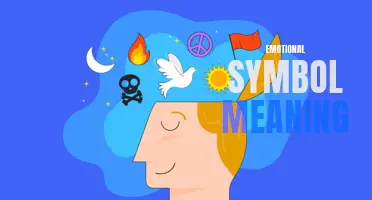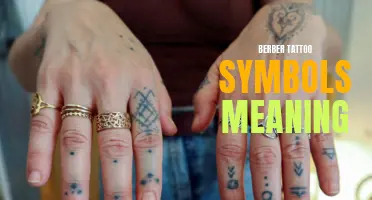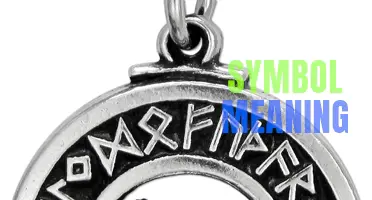
Symbols play an integral role in representing the intricate bond between a mother and daughter. These symbols hold deep meaning and serve as a reminder of the unbreakable connection shared between two strong, compassionate souls. Whether it's a delicate piece of jewelry, a powerful image, or a timeless tattoo, these symbols encapsulate the unconditional love and unwavering support that characterizes the mother-daughter relationship. Join me as we explore the enchanting world of symbols that signify the profound bond between a mother and daughter, celebrating the beauty and strength inherent in their unbreakable tie.
What You'll Learn
- What are some common symbols that represent motherhood and daughters?
- Are there any specific symbols that are universally recognized as representing the mother-daughter relationship?
- Are there different symbols that represent mothers and daughters individually, or are they typically represented together?
- How have these symbols evolved over time, and are there any new symbols that have emerged in recent years?
- Are there any cultural or geographical variations in symbols that represent the mother-daughter relationship?

What are some common symbols that represent motherhood and daughters?
Motherhood is a powerful and universal symbol that represents love, nurturing, and protection. Throughout history, artists and writers have used various symbols to convey these sentiments. Similarly, the bond between mothers and daughters is often seen as profound and unique. To depict this special relationship, symbols have been used to represent the connection between mothers and daughters.
One of the most well-known symbols of motherhood is the Madonna and Child. This religious symbol portrays the Virgin Mary holding baby Jesus. The image is often seen as a representation of the unconditional love and devotion that a mother has for her child. The Madonna and Child is often depicted in artwork and can be found in sculptures, paintings, and stained glass windows in churches around the world.
Another symbol of motherhood is the heart. The heart is often used to represent love and emotions, which are integral aspects of the mother-daughter relationship. This symbol can be found in various forms, such as jewelry and tattoos, to symbolize the bond between a mother and her daughter. The heart is a timeless symbol that transcends cultural boundaries and is universally understood.
Flowers, particularly roses, are also commonly used symbols to represent motherhood. Roses are often associated with love and beauty, making them a fitting symbol to express the love between a mother and her daughter. In many cultures, giving roses is a symbolic gesture to honor mothers on Mother's Day or other special occasions. The delicate petals and sweet fragrance of roses evoke feelings of love and gratitude, making them a perfect symbol for motherhood.
Butterflies are another symbol often associated with motherhood and daughters. Butterflies represent transformation and growth, which are both integral parts of the mother-daughter relationship. As daughters grow up, they go through various stages of development and transformation, much like a caterpillar turning into a butterfly. The butterfly symbolizes the beauty and freedom that comes with growth, and the bond between a mother and her daughter can be seen as a journey of growth and transformation.
Lastly, the infinity symbol has become increasingly popular as a symbol of the unbreakable bond between mother and daughter. The infinity symbol, which looks like a sideways figure-eight, represents eternity and endlessness. It signifies the infinite love and connection between a mother and her daughter. This symbol is often used in jewelry, such as necklaces and bracelets, to remind mothers and daughters of their everlasting bond.
In conclusion, there are several common symbols that represent motherhood and daughters. The Madonna and Child, heart, roses, butterflies, and the infinity symbol are all powerful symbols that convey the love, nurturing, and protection that mothers provide for their daughters. These symbols remind us of the special bond between mothers and daughters and the eternal nature of their relationship.
Exploring the Hidden Symbolism and Rich Meanings of Chumash Symbols
You may want to see also

Are there any specific symbols that are universally recognized as representing the mother-daughter relationship?
Symbols play a significant role in representing different relationships and emotions. When it comes to the mother-daughter relationship, there are several symbols that are universally recognized. These symbols encapsulate the deep bond, love, and connection between a mother and her daughter.
- The Heart Symbol: The heart symbolizes love and affection, making it a popular representation of the mother-daughter relationship. The heart-shaped symbol often signifies the unconditional love that a mother has for her daughter and vice versa. It is a reminder of the emotional bond that exists between them, regardless of any circumstances.
- Infinity Symbol: The infinity symbol, a sideways figure-eight, represents eternity and the endless nature of the mother-daughter relationship. It symbolizes the infinite love, support, and devotion that mothers and daughters have for each other. This symbol is often used to convey the idea that a mother's love for her daughter is limitless and will endure for a lifetime.
- The Tree of Life: The tree of life is a symbol that represents the interconnectedness and continuity of life. In the context of the mother-daughter relationship, it signifies the passing down of wisdom, knowledge, and values from one generation to another. The branches of the tree symbolize the different paths and experiences that a mother and daughter navigate together, while the roots represent the strong foundation and shared heritage they have.
- The Lotus Flower: The lotus flower is a symbol of purity, beauty, and spiritual enlightenment. In the mother-daughter relationship, the lotus flower represents the strength, resilience, and growth that can occur within the bond. Despite the challenges and obstacles they might face, like the lotus flower emerging from muddy waters, a mother and daughter can find strength and beauty within their connection.
- The Butterfly: The butterfly is often used to represent transformation, change, and growth. In the context of the mother-daughter relationship, it signifies the different stages of life that a mother and daughter go through together. From the early stages of childhood to adolescence and adulthood, the butterfly represents the ever-evolving nature of their bond.
These symbols are recognized across different cultures and backgrounds as representations of the deep and complex relationship between mothers and daughters. They serve as reminders of the love, support, and connection that exists within this unique bond. Whether it be through jewelry, art, or other visual representations, these symbols continue to be cherished and valued by mothers and daughters alike.
What Does the Lock Symbol Mean on Android: Understanding Android Security Features
You may want to see also

Are there different symbols that represent mothers and daughters individually, or are they typically represented together?
Mothers and daughters have a special bond that is often represented in various symbols, both individually and together. In different cultures and societies, there are several symbols that represent these relationships.
One of the most common symbols that represent mothers is the heart. The heart symbolizes love and compassion, which are qualities often associated with mothers. Many jewelry pieces, such as necklaces and bracelets, feature heart-shaped pendants to honor and celebrate mothers. Additionally, flowers like roses and tulips are often given as gifts to show appreciation for mothers.
For daughters, the butterfly is a common symbol. Butterflies symbolize transformation and growth, which are important aspects of a daughter's development. Butterflies also represent freedom and independence, qualities that are often associated with daughters as they navigate the world on their own. Many daughters choose to get butterfly tattoos or wear butterfly-themed jewelry to symbolize their connection with their mothers and their own personal growth.
However, it is also common to find symbols that represent the bond between mothers and daughters together. The infinity symbol is a popular choice to represent this connection. The infinity symbol, which looks like a sideways number eight, represents eternity and endless love. Mothers and daughters often gift each other infinity jewelry, such as necklaces or bracelets, to symbolize their unbreakable bond.
Another symbol that represents the relationship between mothers and daughters is the nest. A nest symbolizes a place of comfort, protection, and nurturing. It represents the home and the safe space that a mother creates for her daughter. Many mothers and daughters choose to have matching nest tattoos or wear jewelry with nest pendants to symbolize their shared connection and the love they have for each other.
Overall, there are various symbols that represent mothers and daughters individually and together. These symbols reflect the deep love and bond between mothers and daughters, celebrating their unique and special relationship. Whether it's through heart-shaped pendants, butterfly tattoos, or infinity jewelry, these symbols serve as a meaningful reminder of the love, support, and connection between mothers and daughters.
The Symbolic Meanings of Chrismons: Unlocking the Spiritual Significance of These Religious Symbols
You may want to see also

How have these symbols evolved over time, and are there any new symbols that have emerged in recent years?
Symbols have always played a significant role in human communication, helping to convey complex ideas and concepts in a simplified form. Throughout history, symbols have evolved and changed to reflect the changing needs and beliefs of society. In recent years, new symbols have emerged, reflecting the digital age we live in today.
One example of symbol evolution is the peace symbol. Originally created in 1958 as a logo for the British Campaign for Nuclear Disarmament, the peace symbol quickly became associated with the broader anti-war movement. Its simplicity—a circle with three lines—made it instantly recognizable and easy to reproduce. Over time, the peace symbol has come to represent not just opposition to war but also a broader desire for harmony and unity. Today, the peace symbol can be seen on posters, clothing, and even in social media hashtags.
Similarly, the gender symbol is another symbol that has evolved over time. The gender symbol, representing male and female, is based on the ancient Roman symbols for Mars and Venus. In recent years, there has been a push for more inclusive symbols that reflect the diversity of gender identities. As a result, new symbols have emerged, such as the transgender symbol—a combination of the male and female symbols with an arrow pointing upwards, representing progress and movement.
In addition to the evolution of existing symbols, new symbols have emerged to reflect the digital age. For example, the hashtag symbol (#) has become a powerful symbol in social media, representing trends and allowing users to categorize and search for specific content. Originally used as a simple organizational tool, the hashtag has evolved into a symbol of shared experiences and communal conversations.
Another symbol that has emerged in recent years is the emoji. Emojis are small pictographs that represent emotions, objects, or ideas and are commonly used in text messages and social media posts. Emojis allow for more nuanced communication and can convey thoughts and feelings that may be difficult to express in words alone. From smiley faces to animals to food items, there is an emoji for almost everything, making them a popular form of communication in the digital age.
Symbols have always been an essential part of human communication, and they continue to evolve and adapt to the needs of society. From the peace symbol to the gender symbol to the hashtag and emoji, symbols play a crucial role in helping us express complex ideas and emotions in a simplified form. Whether it be through ancient symbols that have stood the test of time or new symbols that emerge in response to societal changes, symbols continue to shape the way we communicate and understand the world around us.
How to Calculate Mean Symbol in Excel: A Step-by-Step Guide
You may want to see also

Are there any cultural or geographical variations in symbols that represent the mother-daughter relationship?
Symbols play a significant role in representing various relationships and emotions in different cultures around the world. The mother-daughter relationship, in particular, is a complex and multifaceted bond that is cherished in numerous societies. While there are universal symbols such as the heart or the infinity sign that can represent this connection, there are also cultural and geographical variations in symbols that portray the mother-daughter relationship.
One such symbol is the Celtic Knot, which represents an unbreakable bond between two individuals. In Celtic culture, mothers and daughters are often seen as interconnected souls, and the Celtic Knot is a symbol that embodies this idea. The intricate weaving of the knot symbolizes the inseparable bond between the two, reflecting the strength and depth of their relationship.
In Chinese culture, the Jade Pendant is a symbol often associated with the mother-daughter relationship. Jade is considered a precious stone that represents purity, beauty, and wisdom. Giving a jade pendant to a daughter signifies the mother's wishes for her to possess these qualities and to lead a successful and fulfilling life. This symbol reflects the value placed on the mother-daughter relationship in Chinese society and the desire for the daughter to inherit her mother's virtues.
In Hinduism, the Goddess Durga is often used as a symbol for the mother-daughter relationship. Durga is revered as the divine mother, representing strength, protection, and nurturing. The relationship between a mother and daughter is seen as a reflection of the divine bond, where the mother protects and guides her daughter through life's challenges. The image of Durga holding her daughter, Saraswati or Lakshmi, is a powerful representation of the mother-daughter connection and the love and protection that comes with it.
In Native American culture, the Dreamcatcher is a symbol associated with the mother-daughter bond. The Dreamcatcher is traditionally believed to protect individuals from negative dreams and energies. In the context of the mother-daughter relationship, the Dreamcatcher represents the mother's role in shielding her daughter from harm and negativity, ensuring her safety and well-being.
These are just a few examples of the cultural and geographical variations in symbols that represent the mother-daughter relationship. Symbols are deeply rooted in the cultural beliefs and values of a society, and they serve as a way to express and honor the unique qualities of this special bond. Whether it's through ancient Celtic knots, precious jade pendants, or divine Hindu goddesses, these symbols encapsulate the love, strength, and protection that characterize the mother-daughter relationship across different cultures.
The Symbolic Meaning of Bird Poop in Islam: A Sign of Blessings or Misfortune?
You may want to see also
Frequently asked questions
There are several symbols commonly used to represent the special connection between a mother and daughter. One popular symbol is the infinity symbol, which represents limitless love and eternal bond. Another symbol is a heart intertwined with the infinity symbol, symbolizing the deep love and strong connection between a mother and daughter. Additionally, a lotus flower is often used to represent the mother-daughter bond as it signifies purity, beauty, and growth.
Yes, there are symbols that specifically represent the maternal side and the role of a mother. The Celtic Motherhood Knot is a popular symbol used to represent motherhood. It depicts two hearts intertwined, symbolizing the unbreakable bond between mother and child. The symbol of a tree of life is also commonly used to symbolize the maternal side, as it represents strength, wisdom, and nurturing qualities associated with motherhood.
Certainly! A popular symbol that represents the relationship between a mother and daughter is the Russian nesting doll, also known as Matryoshka. The nesting doll symbolizes the idea that a daughter carries a part of her mother within her, just like the smaller doll nested inside the bigger one. Another symbol for the mother-daughter relationship is the interlocking hearts, which represents the inseparable and devoted love between a mother and her daughter. Finally, the symbol of a butterfly is often used to represent the transformation and growth that comes with the mother-daughter relationship.







